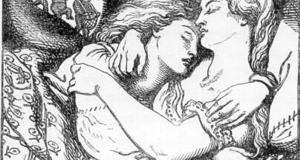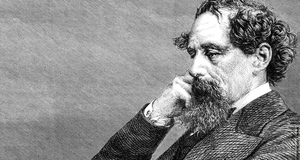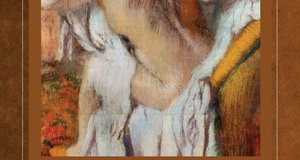Featured Article:Women's Struggles in Industrialized Victorian London as Depicted in Charles Dickens's Hard Times and Christina Rossetti's Goblin Market
By
2016, Vol. 8 No. 09 | pg. 1/1 The Victorian Age was a time of rapid economic, social, and cultural change throughout England. Beginning in the late 1700s and early 1800s, industry began to take shape in Britain, launching England into an era characterized by “momentous and intimidating” social movements, surprising inventions, and a remarkable energy driving the time (“Victorian Age” 1099). This culminated under the reign of Queen Victoria (1837-1901), as people migrated from the country to the city in the hopes of finding better wages as a result of the Industrial Revolution (Service 83). The changes brought about by massive population movement and industrialization impacted the full breadth of life for all of England’s citizens, while the unprecedented speed of this social and economic revolution afforded people far too little time to process each new innovation before being carried away by the next “torrent of ideas and technologies” (“Victorian Age” 1105). Just like all other citizens, Victorian authors had mixed reactions to the processes of industrialization. Some extolled the virtues of this “new age of promise, progress, and triumph” while others dubbed it the “Time of Troubles” (“Victorian Age” 1105). Those who openly criticized the negative effects of industrial growth—particularly its effects on women’s traditional roles—used their writing as a platform for their ideas. (“Victorian Age” 1117). Charles Dickens’s Hard Times and Christina Rossetti’s “Goblin Market” stand as examples of such politicized writing and provide insight into the atmosphere of the time period while simultaneously commenting on the effects of industrialization on women. The speed, success, and innovation of the Victorian Era was epitomized by the creation of the first London railroad in 1838 (Service 73). Running from Bricklayers’ Arms to Greenwich, the opening of the railroad sparked an interest in expanding travel and trade options that ultimately led to London becoming a major importer of foreign goods to sell to its citizens such as Chinese tea, Indian cotton, and Australian beef (“Victorian Age” 1103). In “Goblin Market,” Christina Rossetti addresses the skepticism associated with the sudden access to previously unattainable goods. The titular goblin merchant men tempt maidens daily with a wide assortment of fruit that could not possibly be grown in the same environment and are not native to England. The goblins’ claims that they have fruits like “pine-apples,” “apricots,” “pomegranates,” and “citrons from the South” indicate that they, like London business men, are able to import goods on a large scale (Rosetti 13-14, 21, 29). By casting the menacing goblins as importers, Rossetti uses them as stand-ins for the British businessmen in order to communicate her negative opinion of industry. This is furthered by Laura’s warning to her sister that they must not buy the foreign fruit because they do not know “upon what soil [the fruits] feed their hungry roots” (Rossetti 44-45). This assertion casts doubt upon the safety and trustworthiness of the goods that were not natively English and permeated the British economy during the 19th century.This passage also allows Rossetti to comment on the dangers English women were facing as newly targeted shoppers. Shortly after the trade boom, the creation of the department store caused leisurely women to be courted as consumers for the first time (“Victorian Age” 1111). This new ability of women to contribute to the economy directly translates to the story of Laura and Lizzie as the goblin men’s calls of “come buy, come buy” can only be heard by maidens who have never before partaken of their goods (Rossetti 4). The negative perception of businesses targeting women is made clear by Lizzie’s statement that the offers of the goblin men “should not charm us” because “their evil gifts would harm us” (Rossetti 65-66). The characterization of the merchants as sinister, persistent goblins and their obviously imported fruits as wicked and dangerous is emphasized by Lizzie’s story of Jeanie—a girl who ignored the warnings of others, gave in to the goblins’ cries, and indulged in their juicy products. Through Lizzie’s account of Jeanie’s life after eating the goblins’ fruit, Rossetti is able to assert that once women have had a taste of consumerism their appetite for buying will become insatiable and self-destructive just as Jeanie “pined and pined away” her life searching for a way to get her hands on more exotic goblin fruit (Rossetti 154). Rossetti continues this symbolic narrative into the account of Laura’s experiences after succumbing to the goblin vendors’ “sugar-baited words” to underscore the fact that the newly awarded opportunity to shop during this time of unhalted economic progress was an inherent temptation to women (Rossetti 234). Just as ladies in Victorian London were suddenly presented with the previously unheard of chance to purchase exotic items, Laura finds herself alone with the goblin men for what appears to be the first time after her sister, recognizing the potential danger of being out at dusk with the goblins, flees from the grove. The goblins’ decisions to greet Laura by giving her “a crown of tendrils, leaves, and rough nuts brown” and to showcase their fruit on a golden dish represent the Victorian advertisers’ creation of ads specifically designed to target and flatter female consumers in order to capitalize on this newfound and inexperienced consumer bloc. (Rossetti 99-100). Although she admittedly “longed [to purchase the fruit], but had no money,” Laura’s revelation that her hair is now an acceptable form of payment can be seen as Rossetti’s commentary on the British women’s sudden ability to participate in the burgeoning economy that had, until this point in time, excluded them (Rossetti 106). Furthermore, Rossetti’s claim that Laura had “never tasted such before” strengthens the comparison between Laura and women of the Victorian Era who were new to the rapidly changing world marketplace (Rossetti 132). The decision to follow this line with the rhetorical question “how should it cloy with length of use” can be clearly read as a warning by Rossetti that women will eventually become sick from eagerly participating in the industrialized business cycle since mass consumption, like the goblins’ fruit, is too sweet to be consumed excessively by those who have never tasted it before (Rossetti 133). Allowing women to take advantage of the innovations in international trade was merely the first way in which the continuous and confusing procession of social reforms sparked by the Industrial Revolution began to grant women both political and economic rights they had previously been denied. Prior to the 1870s, married women in Britain were not allowed to vote, own property, or claim custody of their own children, and immediately forfeited what few legal rights they did have upon tying themselves to their husbands as “one body” in marriage (Victorian Age” 1110). At the same time, unmarried or “redundant” women were desperate to improve their quality of life but had so few opportunities for social advancement that tens of thousands of girls turned to the booming London prostitution industry in order to make a living (“Victorian Age” 1111). The conflict between targeted economic advertising and cultural expectations forced women to suddenly grapple with crumbling gender norms. Efforts made during the Victorian Era to counteract the negative effects of these prevailing antiquated gender stereotypes on women were directly influenced by the abundance of progress stemming from industrialization. Although these strides in social evolution are now regarded as feminist triumphs, as Dickens and Rossetti both point out the upending of women’s traditional roles in society was met with much doubt and uncertainty which led to many questioning whether or not women were prepared for the new, highly technical industrial culture. The female characters in Dickens’s socially critical novel, Hard Times, epitomize the aforementioned internal struggle between upholding time-tested ideas of femininity and assimilating into the fast-paced culture produced by the Industrial Revolution. Traditional Victorian femininity was defined as being a domestic, unadulterated, nurturing creature who enjoyed mundane activities such as creating cross-stitched pillowcases or sketching pastoral scenes. According to this standard, the ideal woman is primarily motivated by an intrinsic desire to marry and fulfill the needs of her husband and children while protecting them from the “squalor” and gloom of the industrial world. As Dickens points out, it is no surprise that this sedentary existence would clash with the fast-paced world 19th century ladies found themselves living in (“Victorian Age” 1111). Through his characterization of Rachael, Louisa, and Mrs. Gradgrind, Dickens is able to showcase the varying degrees to which Victorian women were shaped by their rapidly changing environment and the adverse effects their attempts to incorporate elements of the new cultural climate into their nature had on their ability to fulfill the mold of the ideal woman. Being one of the only nurturing, maternal figures in Dickens’s Hard Times, Rachael represents women who were still clinging to the customary role of Victorian ladies as reliable caretakers and emotional anchors for the men in their lives. This is evidenced by Rachael’s relationship with one of the workers in Coketown’s immense system of industry named Stephen Blackpool. Dickens first introduces Rachael through Stephen as he is frantically searching for her in the darkened streets after completing his shift at the factory. The instant satiation of his rising panic brought on when he finally catches sight of her casts Rachael as accomplishing the main purpose of women during this time: quieting the “savage beast” her husband might become as a result of his time spent toiling away in the “savage jungle of free trade” (“Victorian Age” 1111). Stephen’s immense praise of Rachael’s constancy and ability to encourage him “in that cheering way” for an unspecified number of years prior to this encounter speaks to the level of relentless persistence and determination she has shown in order to continue being an escape for Stephen from the hustle and bustle of Victorian life (Dickens 54). Additionally, Stephen goes on to assert that Rachael’s mere touch is enough to “calm the wild waters of his soul” and “abate the raging sea” within him which aligns Rachael even more with the picturesque Victorian lady (Dickens 62). Rachael’s sympathetic side is further showcased in her interactions with Stephen’s unpredictable, invalid wife. Described as “a disabled drunken creature” and “a creature so foul to look at,” Mrs. Blackpool is detested by everyone she comes in contact with, including her husband (Dickens 55). Rachael’s willingness to look past the woman’s unsavory appearance and behavior while sitting by the bedside and tending to her wounds speaks to the boundlessness of her compassion and feminine need to care for others. In spite of Rachael’s strict adherence to the essential womanly principles of nurturing and selflessness, she is unable to escape the harsh realities of the industrial age unscathed. Although she is in love with Stephen and he with her, Rachael is unable to achieve the ultimate goal of Victorian women—marrying a suitable husband and producing offspring—because of the laws that were in place during this time. As Hard Times was first published in 1854, prior to the Divorce and Marital Causes Act of 1857, the world of Coketown was still governed by religiously motivated laws prohibiting divorce (“Victorian Age” 1111). Rachael’s urging for Stephen to “try to think not” of his desire to separate from his abovementioned wife in order to begin a new life with her and “let the laws be” shows the extent to which she is rendered helpless by both the society in which she lives and her own passive, feminine nature (Dickens 53, 54). Rachael’s inability to turn her strong romantic feelings for Stephen into a marriage shows that even the most idealistic young women suffered during the Victorian Era. The stark contrast between Louisa Gradgrind’s defiant, youthful curiosity and her rigid, fact based upbringing makes her the perfect representation of women attempting to integrate their sense of prescribed Victorian womanhood into the developing industrial culture of the mid-1800s. Like Rachael and her real world counterparts, Louisa is subjected to the wills of the men in her life. Her father’s philosophy that instilling in his daughter only the cold, hard facts and “root[ing] out everything else” is sufficient for her development coincides with the overabundance of new knowledge and scientific discoveries that entered the everyday sphere during the Victorian Age (Dickens 5). Dickens’s description of Louisa’s “eminently practical” father’s attempts to override her emotional nature with only the most irrefutable scientific laws can be viewed as the overwhelming influence London’s industrialized society had on the British women’s behaviors and ways of thinking (Dickens 12). Although this highly factual way of life affords the ladies an extensive understanding of the world around them, it fails to prepare them to deal with the emotional roller coaster that accompanies romantic relationships. Upon learning of Mr. Bounderby’s proposal of marriage from her father, Louisa is uncertain how to respond as this is a matter that must be considered both rationally and emotionally. Her father’s advice to consider Bounderby’s offer “simply as one of tangible Fact” just as she has been taught to her consider all other occurrences in her life, shows the part facts and technology play in corrupting the characteristically feminine objective of obtaining a husband (Dickens 77). As a result of this invasion of facts, the search for a spouse shifts from being purely motivated by the desire to provide love and support for someone else, to being a highly scrutinized endeavor that produces relationships ill-equipped to stand the test of time as evidenced by Louisa’s dealings with James Harthouse. Though she is married to Mr. Bounderby at the time, when Mr. Harthouse expresses his interest in beginning an extramarital affair with her, Louisa claims that “there rose up a rebellion” within her heart against the binding tie of her marriage (Dickens 164). Her assertion that this upheaval was the result of the conflict between her “two individual natures” goes to show the difficulty Victorian women had reconciling the old-fashioned notions of womanliness with the rapidly evolving influences of their industrialized society (Dickens 165). By having Louisa follow this with the statement that these differing aspects of her personality could not be ruled by any “general laws,” Dickens is directly criticizing the oppressive regulations that existed during the Victorian Era (Dickens 165). Louisa’s mother, Mrs. Gradgrind, rounds out the spectrum of Dickens’s symbolic female characters. First introduced as “a little, thin, white, pink-eyed bundle of shawls,” Mrs. Gradgrind’s wholehearted immersion into the pervading culture of facts through her marriage to the factually driven Thomas Gradgrind has left her nearly incapacitated (Dickens 16). Dickens fashions her with “surpassing feebleness” and “imbecility” to allow her to function as a depiction of the Victorian women who completely abandoned the feminine ideals in favor of the technologically advanced nature of the time (Dickens 16). This characterization of Louisa’s mother illustrates the widely accepted Victorian thinking that women were so intellectually inferior to men that they would “buckle under the weight of serious thought” (“Victorian Age” 1111). Through Mrs. Gradgrind’s reactions to Louisa’s unsavory behaviors, Dickens is able to affirm the line of thinking that women cannot solely inhabit the commercialized world of their male contemporaries without sacrificing both their sanity and aspiration of starting a family. In Victorian society, Mrs. Gradgrind’s remark that parenting Louisa is “enough to make one regret ever having had a family at all” spits directly in the face of the traditional way of thinking about women as longing primarily to be mothers and wives (Dickens 17). By creating a character who is reduced to being wholly unfit to rear her children and who verbalizes her desire that should have never been born, Dickens paints an impactful picture of the effects overwhelming amounts of facts, like those produced by the Industrial Revolution, had on women in the 1800s. Charles Dickens and Christina Rossetti works offer a unique glimpse into the conflicted, and muddled world their authors inhabited. Rossetti’s carefully crafted symbolism allows readers in both the 19th and 21st centuries to see past the initial shock and awe that accompanied the sudden international trade boom and more fully understand the potentially detrimental side effects associated with importing foreign goods. Similarly, Charles Dickens’s intentional characterization of the three main female characters effectively communicates the struggles women faced when trying to merge expectations and reality. Together, the two works serve as still relevant expressions of the various ways in which women suffered as a result of their willingness to be suppressed in an attempt to stretch between the shifting demands of their families, and the immovable rock of social standards. These works reflect the effects, the tumultuousness, uncertainty, and forward moving progress of the Victorian Age had on the women of London. ReferencesDickens, Charles. Hard Times. New York: W. W. Norton & Company, Inc., 2001. Print. Rossetti, Christina Georgina. “Goblin Market.” The Poetry Foundation. http://www.poetryfoundation.org/poems-and-poets/poems/detail/44996. 2016. Web. 12 April 2016. Service, Alistair. London 1900. New York: Rizzoli International Publications, Inc., 1979. Print. The Longman Anthology of British Literature Vol 2B. Eds. Damrosch, David and Kevin J.H. Dettmar, Christopher Baswell, Clare Carroll, Heather Henderson, Constance Jordan, Peter J. Manning, Anne Howland Schotter, William Chapman Sharpe, Stuart Sherman, Jennifer Wicke, Susan J. Wolfson. New York: Pearson Education, Inc., 2006. Print. Suggested Reading from Inquiries Journal
Inquiries Journal provides undergraduate and graduate students around the world a platform for the wide dissemination of academic work over a range of core disciplines. Representing the work of students from hundreds of institutions around the globe, Inquiries Journal's large database of academic articles is completely free. Learn more | Blog | Submit Latest in Literature |


















